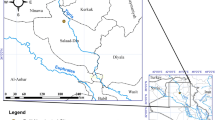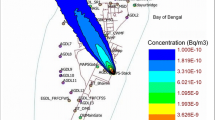Abstract
Nuclear power plants are normally assumed to be safe when their radiation impact in all operational states is kept at a reasonably low level. However, accidentally released radioactive substances and ionizing radiation may lead to a situation that cannot maintain the regulatory prescribed dose limits for internal and external exposure of the personnel and population. Nuclear emergency preparedness and response in nuclear or radiological events have been of concern recently in international communities. Nuclear power plants may need to provide essential information regarding possible scenarios of accidental releases that might have short-term detrimental effects and long-term risks in nearby populated regions. This paper presents a synergistic integration of a source term model and a three-dimensional, time-dependent, numerical model (i.e., HOTMAC/RAPTAD), which was applied to simulate a specific scenario in which a vapor cloud was accidentally released from Maanshan (i.e., the third nuclear power plant) in South Taiwan. It aims at dealing with middle-range risk assessment for nuclear emergency preparedness and response. The solutions of such an integrated modeling platform can be found with numerical analyses that describe the processes of radionuclide generation, transport, decay, and deposition, giving the final risk assessment in a neighboring coastal city—Kaohsiung, South Taiwan. In addition, sensitivity analyses were performed to evaluate the internal consistency of model parameters, which further support the application potentials. Such a modeling technique is valuable because it can characterize the fate and transport of radioactive nuclides over the long term. The case study in South Taiwan uniquely demonstrates the feasibility and significance of such model integration.
















Similar content being viewed by others
References
Applied Physics Laboratory. (1983). A systems study of regional air transport modeling for emergency response application. Rep. No. PPSE T-22. The Johns Hopkins University, Baltimore, Maryland, USA.
Chang, W. B. (1987). Evaluation of accident from nuclear power plant using Gaussian puff model instead of Gaussian plume model. Masters thesis, National Tsing-Hua University, Taiwan, R.O.C.
Garger, E. K., Hoffman, F. O., & Miller, C. W. (1996). Model testing using Chernobyl data: III. Atmospheric resuspension of radionuclides in Ukrainian regions impacted by Chernobyl fallout. Health Physics, 70(1), 18–24. doi:10.1097/00004032-199601000-00004.
Kao, C. -Y. J., & Yamada, T. (1988). Use of the CAPTEX data for evaluations of a long-range transport model with a four-dimensional data assimilation technique. Monthly Weather Review, 116, 293–306. doi:10.1175/1520-0493(1988)116<0293:UOTCDF>2.0.CO;2.
Konoplev, A. A., & Bulgakov, A. A. (1996). Model testing using Chernobyl data: I. wash-off of 90Sr and 137Cs from two experimental plots established in the vicinity of the Chernobyl reactor. Health Physics, 70(1), 8–12. doi:10.1097/00004032-199601000-00002.
Kryshev, I. I., & Sazykina, T. G. (1996). Model testing using Chernobyl data: II. Assessment of the consequences of the radioactive contamination of the Chernobyl nuclear power plant cooling pond. Health Physics, 70(1), 13–17. doi:10.1097/00004032-199601000-00003.
Maryon, R. H. (1994). Modelling the long range transport of radionuclides following a nuclear accident. Nuclear Energy, 33(2), 119–128.
Mellor, G. L., & Yamada, T. (1974). A hierarchy of turbulence closure models for planetary boundary layers. Journal of the Atmospheric Sciences, 31, 1791–1806. doi:10.1175/1520-0469(1974)031<1791:AHOTCM>2.0.CO;2.
Mellor, G. L., & Yamada, T. (1982). Development of a turbulence closure model for geophysical fluid problems. Reviews of Geophysics and Space Physics, 20, 851–875. doi:10.1029/RG020i004p00851.
Micro-Simulation Technology. 2006. PCTRAN/PWR: Personal Computer Transient Analyzer For a Two-loop PWR, http://www.iaea.or.at/OurWork/ST/NE/NENP/NPTDS/Downloads/Simulators/Manual_PCTRAN.pdf
Po, L.-C. (1993). The functionality of PCTRAN. Nuclear Engineering International, 36–39.
Ritchie, L. T., Johnson, J. D., & Blond, R. M. (1983) Calculation of Reactor Accident Consequence (CRAC2), NRC report, NURGE/CR-2326. Sandia National Laboratory, NM, USA.
Sasamori, T. (1968). The radiative cooling calculation for application to general circulation experiments. Journal of Applied Meteorology, 7, 721–729. doi:10.1175/1520-0450(1968)007<0721:TRCCFA>2.0.CO;2.
United States Environmental Protection Agency (US EPA). (1995). US-EPA ISC3, User’s Guide for the Industrial Source Complex Dispersion Model, EPA-454/B-95-003a and EPA-454/B-95-003b.
Yamada, T. (1981). A numerical simulation of nocturnal drainage flow. Journal of the Meteorological Society of Japan, 59, 108–122.
Yamada, T. (1983). Simulations of nocturnal drainage flows by a q2l Turbulence Closure Model. Journal of the Atmospheric Sciences, 40, 91–106. doi:10.1175/1520-0469(1983)040<0091:SONDFB>2.0.CO;2.
Yamada, T. (2004). Merging CFD and atmospheric modeling capabilities to simulate airflows and dispersion in urban areas. Computational Fluid Dynamics, 13(2), 329–341.
Yamada, T., Kao, C.-Y. J., & Bunker, S. (1987). Air flow and air quality simulations over the western intermountainous region with a four-dimensional data assimilation technique. Atmospheric Environment, 23, 539–554. doi:10.1016/0004-6981(89)90003-6.
Yeung, R., & Ching, M. K. (1993). RADIS—a regional nuclear accident consequence analysis model for Hong Kong. Nuclear Technology, 101(2), 123–139.
Author information
Authors and Affiliations
Corresponding author
Rights and permissions
About this article
Cite this article
Tseng, C.C., Chang, NB. Environmental Exposure Assessment for Emergency Response in a Nuclear Power Plant Using an Integrated Source Term and 3D Numerical Model. Environ Model Assess 14, 661–675 (2009). https://doi.org/10.1007/s10666-008-9182-2
Received:
Accepted:
Published:
Issue Date:
DOI: https://doi.org/10.1007/s10666-008-9182-2




